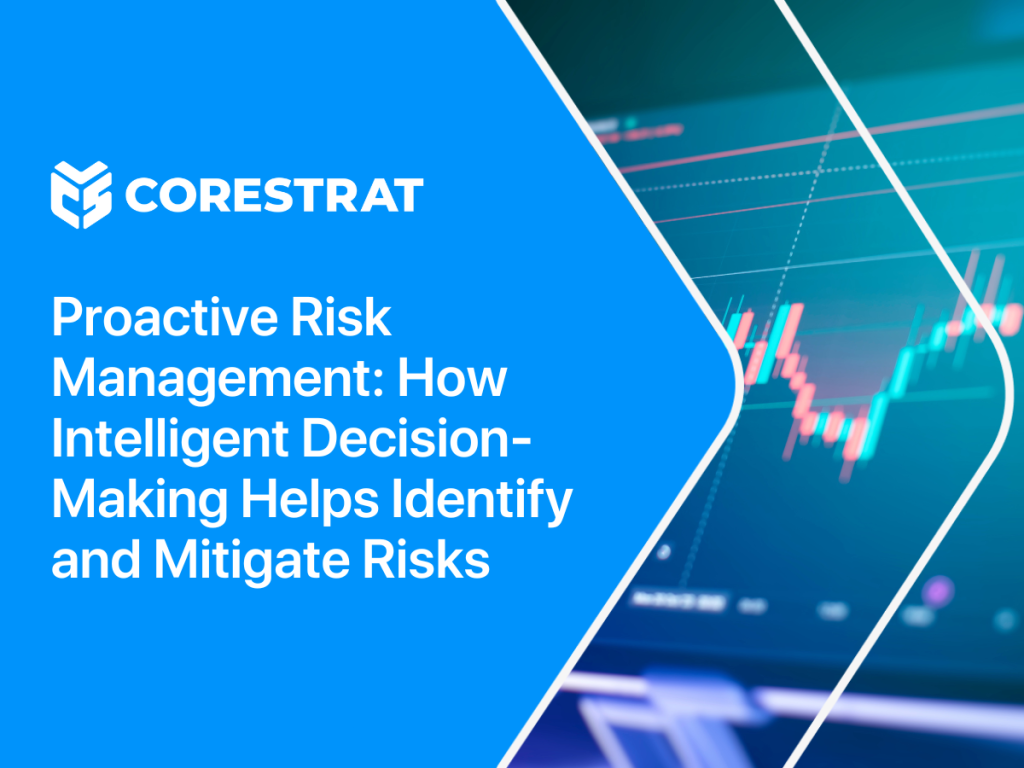Risk management is a critical and delicate aspect of any business, especially in the financial services sector, where money and reputation are constantly on the line. For an organisation to thrive, it’s essential to have a robust risk management system in place. However, many existing systems tend to operate reactively, addressing risks only when they’ve occurred.
What businesses truly need is a system that can anticipate potential problems or discrepancies and take preemptive action—or at least recommend proactive measures. This approach, known as proactive risk management, has the power to save organisations significant amounts of money while protecting their reputation over the long term.
By addressing risks before they escalate, proactive risk management becomes an invaluable asset for any organisation. In the sections that follow, we’ll delve deeper into how this forward-thinking approach works and why it’s a must-have for businesses aiming for sustainable success.

Intelligent Decision-Making: The Game-Changer in Proactive Risk Management
Proactive risk management is all about staying ahead of potential problems instead of reacting to them after the fact. Thanks to advances in intelligent decision-making technologies, businesses now have powerful tools to anticipate and address risks before they escalate.
Predictive Analytics
Imagine being able to foresee a problem before it happens. That’s the power of predictive analytics. By analysing historical data and combining it with real-time insights through predictive models, predictive analytics identifies trends and patterns that signal potential risks.
For example, in the financial sector, predictive analytics can flag customers likely to default on loans by analysing their spending habits, credit history, and market trends. This allows lenders to take preemptive action, like restructuring payment plans or tightening approval criteria for high-risk borrowers.
By shining a light on the road ahead, predictive analytics helps organisations make informed decisions that reduce surprises and mitigate losses.
Machine Learning for Pattern Recognition
Machine learning (ML) takes risk management a step further by teaching systems to detect subtle patterns that humans or traditional methods might overlook. Machine learning algorithms excel at recognising complex patterns that may not be apparent to human analysts or traditional tools. ML systems continuously improve by learning from new data, making them invaluable in detecting subtle and evolving risks.
Let’s say you’re running an online payment platform. Millions of transactions happen daily, and hidden among them could be fraudulent activities. Machine learning algorithms are excellent at spotting anomalies—like a sudden spike in spending from a customer’s account or a transaction made from an unusual location. These insights enable real-time fraud detection and immediate preventive measures.
Real-Time Monitoring
In today’s fast-paced world, risks can emerge anytime, anywhere. That’s where real-time monitoring comes in. Equipped with automation and Internet of Things (IoT) sensors, real-time systems keep a constant eye on operations, ensuring that no potential threat slips through unnoticed.
Picture a bank’s fraud detection system monitoring thousands of credit card transactions every second. If an unusually large transaction occurs in a foreign country minutes after a card is used locally, the system can instantly flag it, block the card, and notify the customer. This proactive approach builds customer trust and ensures peace of mind about their money and data entrusted within the organisation. By leveraging intelligent decisioning systems, banks can thus enhance the customer experience and foster long-term loyalty.
Scenario Planning and Simulation
What if you could “rehearse” potential risks and their impacts? Scenario planning and simulation make this possible. By creating hypothetical situations—like a cyberattack, a market crash, or a supply chain disruption—businesses can evaluate their vulnerabilities and test response strategies.
For example, an IT company might simulate a ransomware attack to see how its systems and teams respond. The insights gained help identify weak points and refine security protocols, ensuring the company is better prepared for the real thing.
These simulations serve as a risk management safety drill, empowering organizations to act decisively and minimise damage when actual threats arise.
Conclusion
Proactive risk management, powered by intelligent decision-making, is no longer a luxury—it is a necessity for businesses. By leveraging predictive analytics, machine learning, real-time monitoring, and simulations, organisations can stay ahead of potential threats and maintain resilience in an ever-changing landscape.
The shift from reactive to proactive strategies not only safeguards assets and reputation but also fosters long-term growth. As a business leader, adopting these advanced tools and technologies will position your organisation to thrive in a risk-laden world.
ID.ai by Corestrat is a cutting-edge proactive risk management platform designed to help organisations evaluate their current standing and identify potential challenges they may encounter in the future. With its robust capabilities to process vast amounts of data and scale seamlessly to meet organisational needs, ID.ai leverages advanced predictive models to forecast potential risks. Additionally, it empowers businesses to simulate real-world scenarios, enabling them to assess the impact of their decisions before implementing them.
 Skip to content
Skip to content


